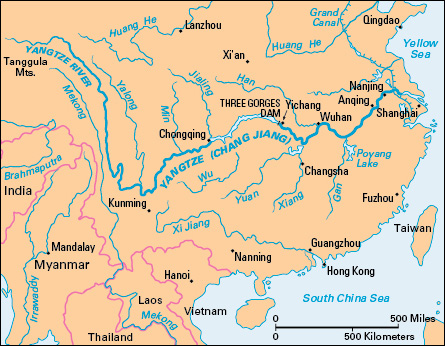Yangtze << yahng dzuh >> River, also called Yangtze Kiang, is the world’s third longest river. Only the Nile and Amazon rivers are longer. It is China’s longest and most important river. To many Chinese, the Yangtze is known as the Chang Jiang, or long river.

The Yangtze River originates in the Tanggula Mountains of Qinghai Province, about 16,000 feet (4,880 meters) above sea level. It follows an irregular 3,900-mile (6,275-kilometer) course to the East China Sea. The waterway flows east, southeast, and then south into the province of Yunnan. From there, it turns northeast across Sichuan Province. It then flows east through central China and enters the East China Sea. The Yangtze and its branches drain about 700,000 square miles (1,800,000 square kilometers).
The high mountains at the Yangtze’s source cause it to flow rapidly for most of its length. In places, mountains more than 1 mile (1.6 kilometers) high form the river’s banks. The great gorges in the river’s upper reaches above Yichang make it one of the most beautiful waterways in the world.
About half of China’s ocean trade is carried over the Yangtze and its branches. Ocean steamers can travel upstream to Wuhan, 680 miles (1,090 kilometers) by river from the coast. Smaller boats can go 1,000 miles (1,600 kilometers) farther inland.
Thousands of Chinese live on the Yangtze on sailing craft called junks. Among the great cities along the Yangtze River are Shanghai, Nanjing, Anqing, and Chongqing. Occasional summer floods temporarily force many people from their homes.
In 1994, construction began in the area above Yichang on the Three Gorges Dam. The dam generates large amounts of hydroelectric power and is expected to control flooding along the Yangtze. The dam created Three Gorges Lake, a reservoir that extends from the dam site hundreds of miles west to Chongqing.
See also Grand Canal; Three Gorges Dam.
